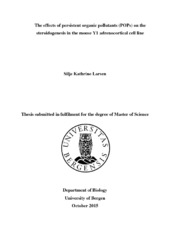The effects of persistent organic pollutants (POPs) on the steroidogenesis in the mouse Y1 adrenocortical cell line
Master thesis
Permanent lenke
https://hdl.handle.net/1956/10716Utgivelsesdato
2015-10-01Metadata
Vis full innførselSamlinger
Sammendrag
The endocrine system refers to glands which secrets hormones that regulates a variety of physiological processes. The adrenal cortex is part of the endocrine hypothalamus-pituitary-adrenal axis, and produces and secretes steroids regulating stress reactions after stimulation by hormones secreted from the brain. Being an organ regulated by hormones, the adrenal cortex is also a potential a target for endocrine disrupting compounds that may mimic endogenous hormone receptor ligands. The Y1 adrenocortical cell line is an in vitro model originating from a tumour in the mouse adrenal cortex, and has maintained the ability to produce and secrete steroids. In this thesis, Y1 cells were exposed to a complex mixture of persistent organic pollutants (POPs), and the effects on steroidogenesis on steroid production and selected steroidogenic enzymes were studied with LC-MS/MS and Western blotting, respectively. Results showed that the overall steroid production in the cells was increased in the highest administered dose of the POP mixture. This indicates that POPs present in the mixture could act as endocrine disruptors and alter the steroidogenesis. More studies of the effects of this mixture might provide more information of the mechanisms behind increased steroidogenesis.
